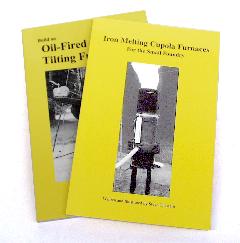|
REVIEW
by Jock Dempsey
These are third generation do-it-yourself books.
They are based on the earlier works and writing of others plus Steve's experience and thus distilled down to near perfection.
C.W. Ammen wrote the first generation of DIY foundry books and I still highly recommend them.
Gingery and others created plans and wrote about fairly primitive DIY backyard systems.
And from these Steve Chastain has evolved the small DIY foundry yet another step.
Building a cupola or tilting furnace is NOT a project for everyone.
These are big serious projects. They can also be dangerous AND they are quite technical.
Steve provides explicit instructions while also providing the technical information so that the more enterprising builder can do their own thing.
And in this too Steve has distilled the information from many references and saved the builder a great deal of time and frustration trying to find the needed calculations that apply specifically to SMALL foundries.

|
Iron Melting Cupola Furnaces, For the Small Foundry:
The coupla is the oldest method of melting cast iron and continues to be used world wide.
Although a simple mechanism the ratios of fuel, air, iron and flux have always been critical and the most important part of the ironmaster's education.
Steve gives the methods for determining the correct blower capacity for a given size coupla and the resulting melt rates.
Using these formulas you may design a coupla of any size you want.
However, the book also describes a couple furnace sizes as examples that can be built without designing your own.
The book covers:
- The construction details of a 7", 10" and 12" cupola.
- A scroll blower appropriate for the furnace
- A Manometer to gauge air flow.
- Operation of the cupola.
|
These small coke fueled melters can produce a tremendous amount iron and are rated in hundreds of pounds per hour.
The hobbiest should consider keeping the furnace small unless there are lots of helpers to keep everything running smoothly.
|
 Building an Oil-Fired Tilting Furnace:
Building an Oil-Fired Tilting Furnace:
This information packed book covers the design and construction of a tilting furnace for melting aluminium or other metals.
The purpose for a tilting furnace is so that one person can pour more metal than they can handle in a pouring ladle or crucible.
The furnace is detailed to run on either propane or oil.
It is suggested to preheat the furnace with propane then switch to oil.
The book covers:
- The construction of the tilting furnace and its burners.
- Oil tank for storing one day's worth of oil.
- A scroll blower appropriate for the furnace
- A Manometer to gauge air flow.
- Operation of the furnace.

Duplication: These books are designed to stand alone so there is some duplication between the two.
This is primarily the blower calculations and design, manometer and pitot tube.
My only compliant about these books is that I like to see detailed assembly drawings, especialy of the tilting furnace.
There are plenty of drawings and photographs but a great deal must be derived from word pictures.
On anvilfire I find myself forced to use word pictures every day but I would prefer to use drawings.
The old saying that one picture is worth a thousand words is true but it should also be said that to produce that picture may require more work than a thousand words.
|
Published by:
Stephen D. Chastain
Jacksonville, FL
Distributed by:
ArtisanIdeas.com
Price 19.95 each
ISBN 0-9702203-0-8 Coupla
ISBN 0-9702203-1-6 Tilting
Links
|




